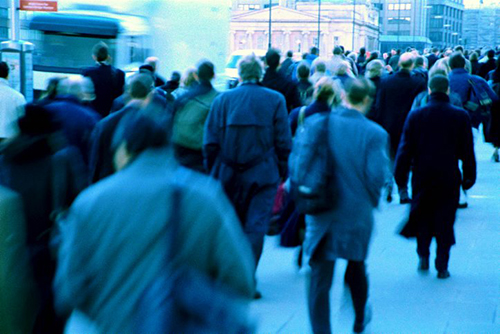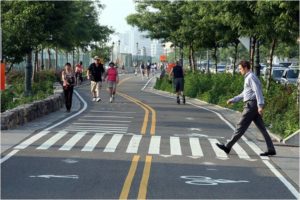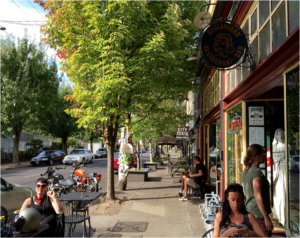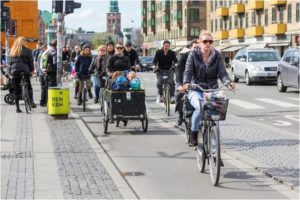Walkability – Set the city free
Walkability – At the core of sustainability
Walkability is defined in Wikipedia as a measure of how friendly an area is to walking. It benefits health, environment and the economy. Presence or absence and quality of foothpaths, sidewalks or other pedestrian rights-of-way, traffic and road conditions, land use patterns, building accessibility, and safety are all factors influencing walkability. Among others Walkability is key to the concept of sustainable urban design.
Walkability is an important part of sustainability, as an area’s walkability reflects so many other sustainable factors that take part in a municipality’s makeup. Accessibility, road and walkway conditions, public transportation program safety and accessibility, general safety and land use patterns all contribute to an area’s walkability. Thus, creating or modifying all of these aspects in an urban area is an essential part of sustainable design and something that holds many benefits for the community. The presence of sidewalks and other walking facilities has proven to increase property value and promote tourism. Because sidewalks and connected, well-maintained pedestrian networks allow citizens the ability to safely and conveniently patronize local shops, businesses, and restaurants. Hence, a town or city can benefit economically from having a more walkable environment.
Almost anyone can take part in the “walkability”
Walkability is a way for any area to create a healthier living environment. Almost anyone can take part in the “walkability” of a town or city no matter how rural or urban. Furthermore, improving the walkability can also have positive impacts on the community from an environmental point of view. Swapping the car against walking or biking will reduce car travel and thereby reduce pollution.
Walkability offers surprising benefits to our health, the environment, our finances, and our communities.
1. Health
Walkability indices correlate with Body Mass Index (BMI). Physical activity can prevent chronic diseases, such as cardiovascular disease, diabetes, hypertension, obesity, depression and osteoporosis. In addition, in a report the World Cancer Research Fund and American Institute for Cancer Research has stated that new developments should be designed to encourage walking, as walking contributes to a reduction of cancer.
2. Enviromental
One of most important benefits of walkability is the decrease of the automobile footprint in the community. While more people choose to walk rather than drive or use public transportation carbon emissions are reduced and space is freed up. Hence, the benefits of fewer emissions include improved health conditions and a better quality of life, less smog, and thus a reduced contribution to global climate change.
3. Socioeconomic
Walkability has proven to provide many economic benefits, including accessibility, and cost savings both to individuals and to the public. Furthermore it increases efficiency of land use, and improves livability. Finally, it also provides economic benefits from improved public health, and driving economic development. It is noteworthy that the benefits of walkability are best guaranteed if the entire system of public corridors is walkable – not limited to certain specialized routes. Furthermore, more sidewalks and increased walkability are good for tourism and will increase property value.
Socioeconomic factors contribute to willingness to choose walking over driving. Income, age, race, ethnicity, education, household status, and having children in a household all influence the choice to walk.
What makes a neighborhood walkable?
- A center: Walkable neighborhoods have a center, whether it is a main street or a public space.
- People: Enough people for businesses to flourish and for public transit to run frequently. Hence it needs to be attractive.
- Mixed income, mixed use: Affordable housing located near businesses.
- Parks and public space: Plenty of public places for people to socialize and play.
- Pedestrian design: Buildings are close to the street while parking lots are relegated to the back. Streets designed to cater for pedestrian safety.
- Schools and workplaces: Close enough that most residents can walk from their homes.
- Complete streets: Streets designed for bicyclists, pedestrians, and transit.
It is noteworthy that a combination of the above characteristics can create a positive reinforcing spiral. For instance, the city can convert parking garages in the city center to affordable housing since it can move parking further out from the center.
How to measure walkability?
Walking audits are one way of assessing and measuring walkability. PERS (Pedestrian Environment Review System) is an established and widely used walking audit tool which has been used extensively in the UK. 2) Furthermore there are also a number of commercial walkability scores, for instance the US site WalkScore.com.
WalkScore.com
This website offers an easy way to find cities or areas Walk Score, and even for some cities Transit- and and Bike Scores.
Examples on scores in some cities (0-100):
New York City Walk Score: 100 (Walker´s paradise)
Amsterdam Walk Score: 100 (Walker´s paradise)
Stockholm Walk Score: 99 (Walker´s paradise)
Sydney Walk Score: 63
London Walk Score: 49 (Car-dependent city)
https://www.redfin.com/how-walk-score-works is available for any address in the United States, Canada, and Australia.
Copenhagen – worlds best bicycle city
Last year Copenhagen rated best bicycle city in the world, beating the bicycle Mecca, Amsterdam for the first time. Today more than 60% are biking to their jobs in Copenhagen, while only 14% are using cars. Biking rates are increasing due to the fact that it is now free to bring bikes on the subway. Moreover, the municipality is rebuilding the city with focus on how to attract and support more people to change from using cars to bikes.
Consequently Copenhagen will continue and invest around 15 MEURO in building new biking lanes in 2017.
Summary
Many countries and municipalities realize today that improved walkability and cyclability will be an important urban design requirement going forward. This is since walkability and cyclability provide a range of benefits including health, enviromental and socioeconomic benefits.
New York City is one of the cities that works hard to increase its walkability. As a result New York ranks #1 in the US with a Walk score of 89, followed by San Fransisco (86) and Boston (81).
Sources
WIKIPEDIA
ICMA – Center for Sustainable Communities (icma.org)
https://trlsoftware.co.uk/products/street_auditing/pers
eSvd.se 2017-04-02
https://www.walkscore.com/walkable-neighborhoods.html




